AGTR1rs5186 Polymorphism Is Associated with the Risk of Restenosis after Percutaneous Coronary Intervention: A Meta-Analysis
Abstract
1. Introduction
2. Materials and Methods
2.1. Search Strategy
2.2. Selection and Exclusion Criteria
2.3. Data Extraction
2.4. Statistical Analysis
3. Results
3.1. Study Characteristics
3.2. Quantitative Synthesis
3.3. Sensitivity Analysis
3.4. Publication Bias
4. Discussion
Author Contributions
Funding
Institutional Review Board Statement
Informed Consent Statement
Data Availability Statement
Conflicts of Interest
References
- Vos, T.; Lim, S.S.; Abbafati, C.; Abbas, K.M.; Abbasi, M.; Abbasifard, M.; Abbasi-Kangevari, M.; Abbastabar, H.; Abd-Allah, F.; Abdelalim, A.; et al. Global burden of 369 diseases and injuries in 204 countries and territories, 1990–2019: A systematic analysis for the Global Burden of Disease Study 2019. Lancet 2020, 396, 1204–1222. [Google Scholar] [CrossRef]
- Roth, G.A.; Mensah, G.A.; Johnson, C.O.; Addolorato, G.; Ammirati, E.; Baddour, L.M.; Barengo, N.C.; Beaton, A.Z.; Benjamin, E.J.; Benziger, C.P.; et al. Global Burden of Cardiovascular Diseases and Risk Factors, 1990–2019: Update From the GBD 2019 Study. J. Am. Coll. Cardiol. 2020, 76, 2982–3021. [Google Scholar] [CrossRef] [PubMed]
- Borovac, J.A.; D’Amario, D.; Vergallo, R.; Porto, I.; Bisignani, A.; Galli, M.; Annibali, G.; Montone, R.A.; Leone, A.M.; Niccoli, G.; et al. Neoatherosclerosis after drug-eluting stent implantation: A novel clinical and therapeutic challenge. Eur. Hear. J.-Cardiovasc. Pharmacother. 2019, 5, 105–116. [Google Scholar] [CrossRef] [PubMed]
- Galløe, A.M.; Kelbæk, H.; Thuesen, L.; Hansen, H.S.; Ravkilde, J.; Hansen, P.R.; Christiansen, E.H.; Abildgaard, U.; Stephansen, G.; Lassen, J.F.; et al. 10-Year Clinical Outcome After Randomization to Treatment by Sirolimus- or Paclitaxel-Eluting Coronary Stents. J. Am. Coll. Cardiol. 2017, 69, 616–624. [Google Scholar] [CrossRef]
- Bønaa, K.H.; Mannsverk, J.; Wiseth, R.; Aaberge, L.; Myreng, Y.; Nygård, O.; Nilsen, D.W.; Kløw, N.-E.; Uchto, M.; Trovik, T.; et al. Drug-Eluting or Bare-Metal Stents for Coronary Artery Disease. N. Engl. J. Med. 2016, 375, 1242–1252. [Google Scholar] [CrossRef]
- Sabaté, M.; Brugaletta, S.; Cequier, A.; Iñiguez, A.; Serra, A.; Jiménez-Quevedo, P.; Mainar, V.; Campo, G.; Tespili, M.; den Heijer, P.; et al. Clinical outcomes in patients with ST-segment elevation myocardial infarction treated with everolimus-eluting stents versus bare-metal stents (EXAMINATION): 5-year results of a randomised trial. Lancet 2016, 387, 357–366. [Google Scholar] [CrossRef]
- Miki, K.; Fujii, K.; Kawasaki, D.; Shibuya, M.; Fukunaga, M.; Imanaka, T.; Tamaru, H.; Sumiyoshi, A.; Nishimura, M.; Horimatsu, T.; et al. Intravascular Ultrasound–Derived Stent Dimensions as Predictors of Angiographic Restenosis Following Nitinol Stent Implantation in the Superficial Femoral Artery. J. Endovasc. Ther. 2016, 23, 424–432. [Google Scholar] [CrossRef]
- Prasad, A.M.; Morgan, D.A.; Nuno, D.W.; Ketsawatsomkron, P.; Bair, T.B.; Venema, A.N.; Dibbern, M.E.; Kutschke, W.J.; Weiss, R.M.; Lamping, K.G.; et al. Calcium/Calmodulin-Dependent Kinase II Inhibition in Smooth Muscle Reduces Angiotensin II–Induced Hypertension by Controlling Aortic Remodeling and Baroreceptor Function. J. Am. Heart Assoc. 2015, 4, e001949. [Google Scholar] [CrossRef]
- Wang, H.; Weihrauch, D.; Kersten, J.R.; Toth, J.M.; Passerini, A.G.; Rajamani, A.; Schrepfer, S.; LaDisa, J.F. Alagebrium inhibits neointimal hyperplasia and restores distributions of wall shear stress by reducing downstream vascular resistance in obese and diabetic rats. Am. J. Physiol. Circ. Physiol. 2015, 309, H1130–H1140. [Google Scholar] [CrossRef][Green Version]
- Qin, Z.; Zheng, F.-W.; Zeng, C.; Zhou, K.; Geng, Y.; Wang, J.-L.; Li, Y.-P.; Ji, Q.-W.; Zhou, Y.-J. Elevated Levels of Very Low-density Lipoprotein Cholesterol Independently Associated with In-stent Restenosis in Diabetic Patients after Drug-eluting Stent Implantation. Chin. Med. J. Engl. 2017, 130, 2326–2332. [Google Scholar] [CrossRef]
- Alraies, M.C.; Darmoch, F.; Tummala, R.; Waksman, R. Diagnosis and management challenges of in-stent restenosis in coronary arteries. World J. Cardiol. 2017, 9, 640–651. [Google Scholar] [CrossRef] [PubMed]
- Langeveld, B.; Roks, A.J.M.; Tio, R.A.; Voors, A.A.; Zijlstra, F.; van Gilst, W.H. Renin-Angiotensin System Intervention to Prevent In-Stent Restenosis. J. Cardiovasc. Pharmacol. 2005, 45, 88–98. [Google Scholar] [CrossRef] [PubMed]
- Hamon, M.; Amant, C.; Bauters, C.; Richard, F.; Helbecque, N.; Passard, F.; McFadden, E.P.; Lablanche, J.-M.; Bertrand, M.E.; Amouyel, P. Dual Determination of Angiotensin-Converting Enzyme and Angiotensin-II Type 1 Receptor Genotypes as Predictors of Restenosis After Coronary Angioplasty. Am. J. Cardiol. 1998, 81, 79–81. [Google Scholar] [CrossRef]
- Völzke, H.; Hertwig, S.; Rettig, R.; Motz, W. The angiotensinogen gene 235T variant is associated with an increased risk of restenosis after percutaneous transluminal coronary angioplasty. Clin. Sci. 2000, 99, 19–25. [Google Scholar] [CrossRef]
- Hertwig, S.; Völzke, H.; Robinson, D.M.; Motz, W.; Rettig, R. Angiotensinogen M235T gene polymorphism and recurrent restenosis after repeated percutaneous transluminal coronary angiography. Clin. Sci. 2002, 103, 101–106. [Google Scholar] [CrossRef]
- Wijpkema, J.S.; van Haelst, P.L.; Monraats, P.S.; Bruinenberg, M.; Zwinderman, A.H.; Zijlstra, F.; van der Steege, G.; de Winter, R.J.; Doevendans, P.A.F.M.; Waltenberger, J.; et al. Restenosis after percutaneous coronary intervention is associated with the angiotensin-II type-1 receptor 1166A/C polymorphism but not with polymorphisms of angiotensin-converting enzyme, angiotensin-II receptor, angiotensinogen or heme oxygenase-1. Pharmacogenet. Genomics 2006, 16, 331–337. [Google Scholar] [CrossRef]
- Li, Y.; Chen, F.; Zhang, X.; Gao, Y.; Wu, C.; Li, H.; Zhang, Y. Angiotensin type 1 receptor A1166C gene polymorphism is associated with endothelial dysfunction and in-stent restenosis after percutaneous coronary intervention. Int. J. Clin. Exp. Pathol. 2015, 8, 7350–7357. [Google Scholar]
- Zhu, M.; Yang, M.; Lin, J.; Zhu, H.; Lu, Y.; Wang, B.; Xue, Y.; Fang, C.; Tang, L.; Xu, B.; et al. Association of seven renin angiotensin system gene polymorphisms with restenosis in patients following coronary stenting. J. Renin-Angiotensin-Aldosterone Syst. 2017, 18, 147032031668877. [Google Scholar] [CrossRef]
- Zeng, W.; Zhang, R.; Li, R.; Luo, J.; Hu, X. Association of the Endothelial Nitric Oxide Synthase Gene T786C Polymorphism with In-Stent Restenosis in Chinese Han Patients with Coronary Artery Disease Treated with Drug-Eluting Stent. PLoS ONE 2017, 12, e0170964. [Google Scholar] [CrossRef]
- Azova, M.; Timizheva, K.; Aissa, A.A.; Blagonravov, M.; Gigani, O.; Aghajanyan, A.; Tskhovrebova, L. Gene Polymorphisms of the Renin-Angiotensin-Aldosterone System as Risk Factors for the Development of In-Stent Restenosis in Patients with Stable Coronary Artery Disease. Biomolecules 2021, 11, 763. [Google Scholar] [CrossRef]
- Jiang, Y.-F.; Chen, M.; Zhang, N.-N.; Yang, H.-J.; Xu, L.-B.; Rui, Q.; Sun, S.-J.; Yao, J.-L.; Zhou, Y.-F. Association between KCNE1 G38S gene polymorphism and risk of atrial fibrillation: A PRISMA-compliant meta-analysis. Medicine 2017, 96, e7253. [Google Scholar] [CrossRef] [PubMed]
- Moher, D.; Liberati, A.; Tetzlaff, J.; Altman, D.G.; The PRISMA Group. Preferred reporting items for systematic reviews and meta-analyses: The PRISMA statement. BMJ 2009, 339, b2535. [Google Scholar] [CrossRef] [PubMed]
- Stang, A. Critical evaluation of the Newcastle-Ottawa scale for the assessment of the quality of nonrandomized studies in meta-analyses. Eur. J. Epidemiol. 2010, 25, 603–605. [Google Scholar] [CrossRef] [PubMed]
- Ribichini, F.; Ferrero, V.; Rognoni, A.; Vacca, G.; Vassanelli, C. Angiotensin Antagonism in Coronary Artery Disease: Results after Coronary Revascularisation. Drugs 2005, 65, 1073–1096. [Google Scholar] [CrossRef]
- Balakumar, P.; Jagadeesh, G. A century old renin-angiotensin system still grows with endless possibilities: AT1 receptor signaling cascades in cardiovascular physiopathology. Cell Signal 2014, 26, 2147–2160. [Google Scholar] [CrossRef]
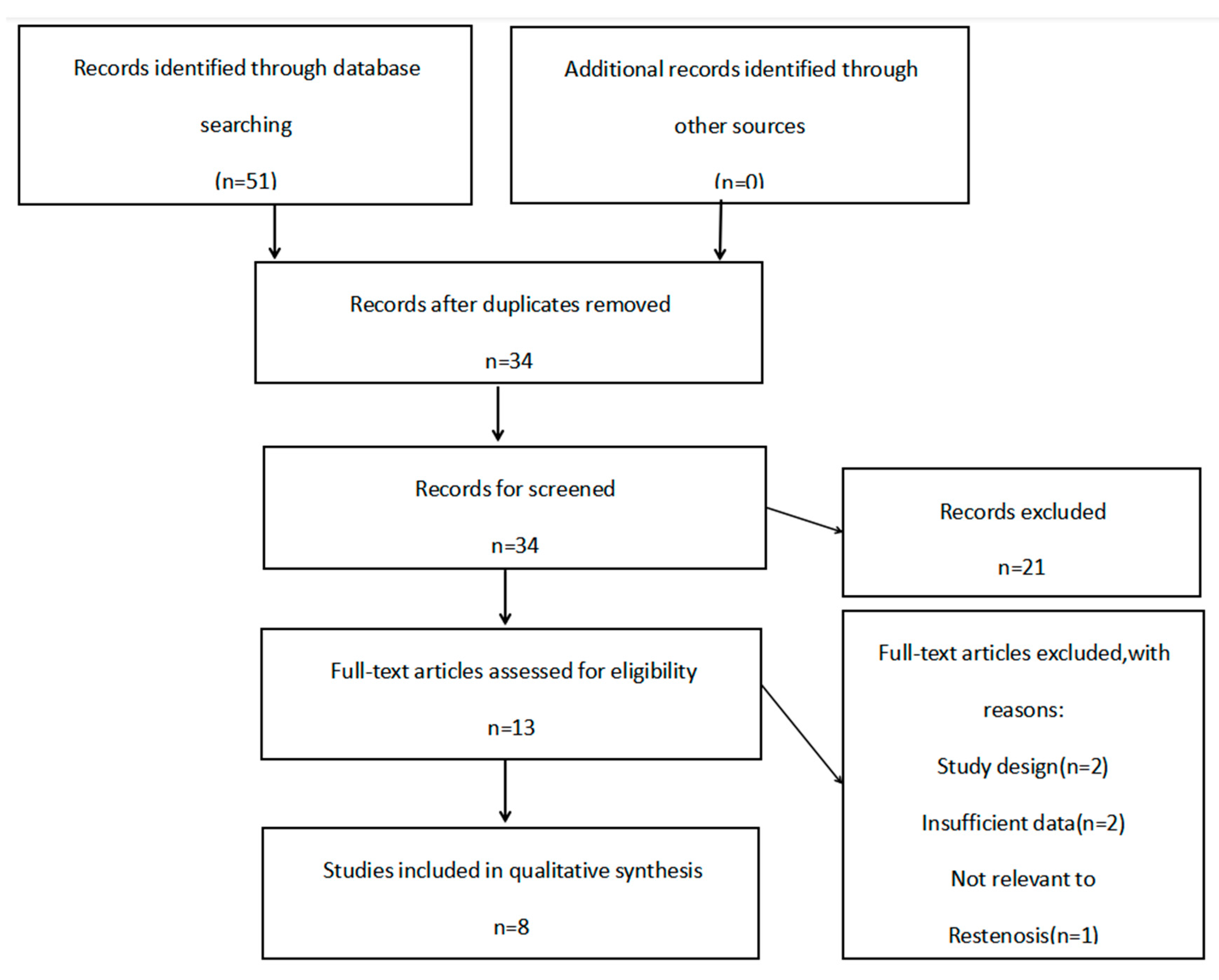
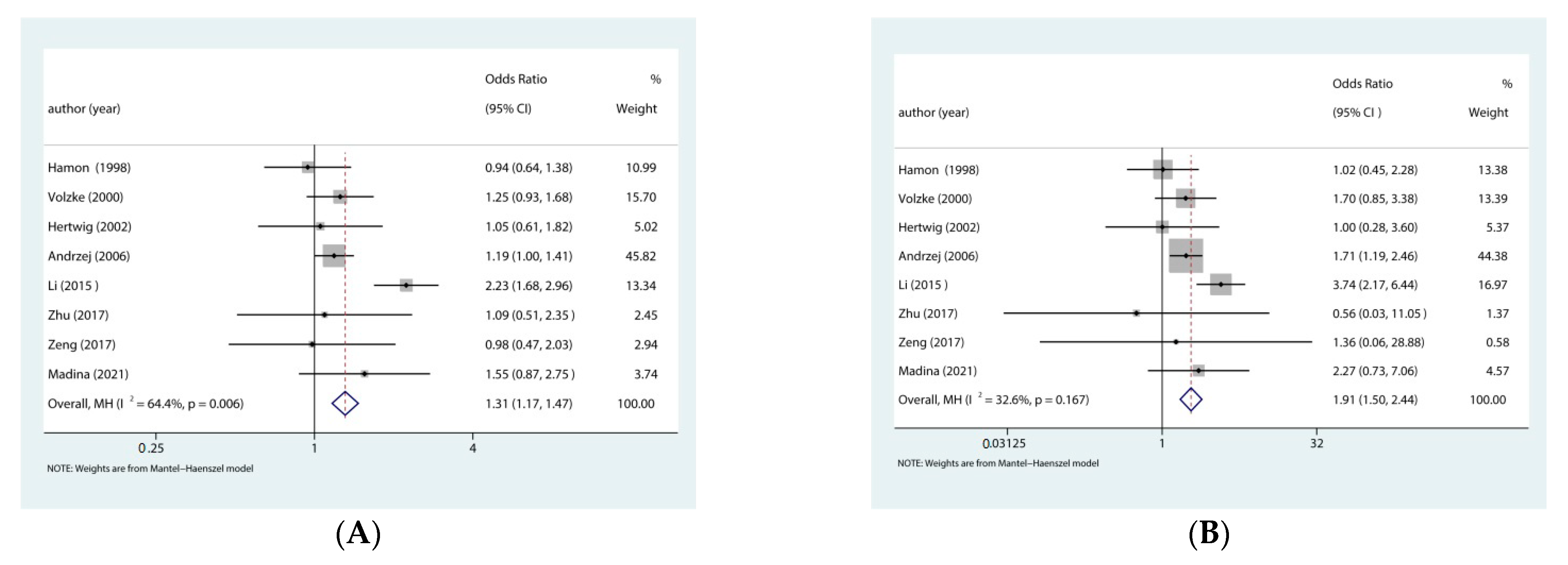
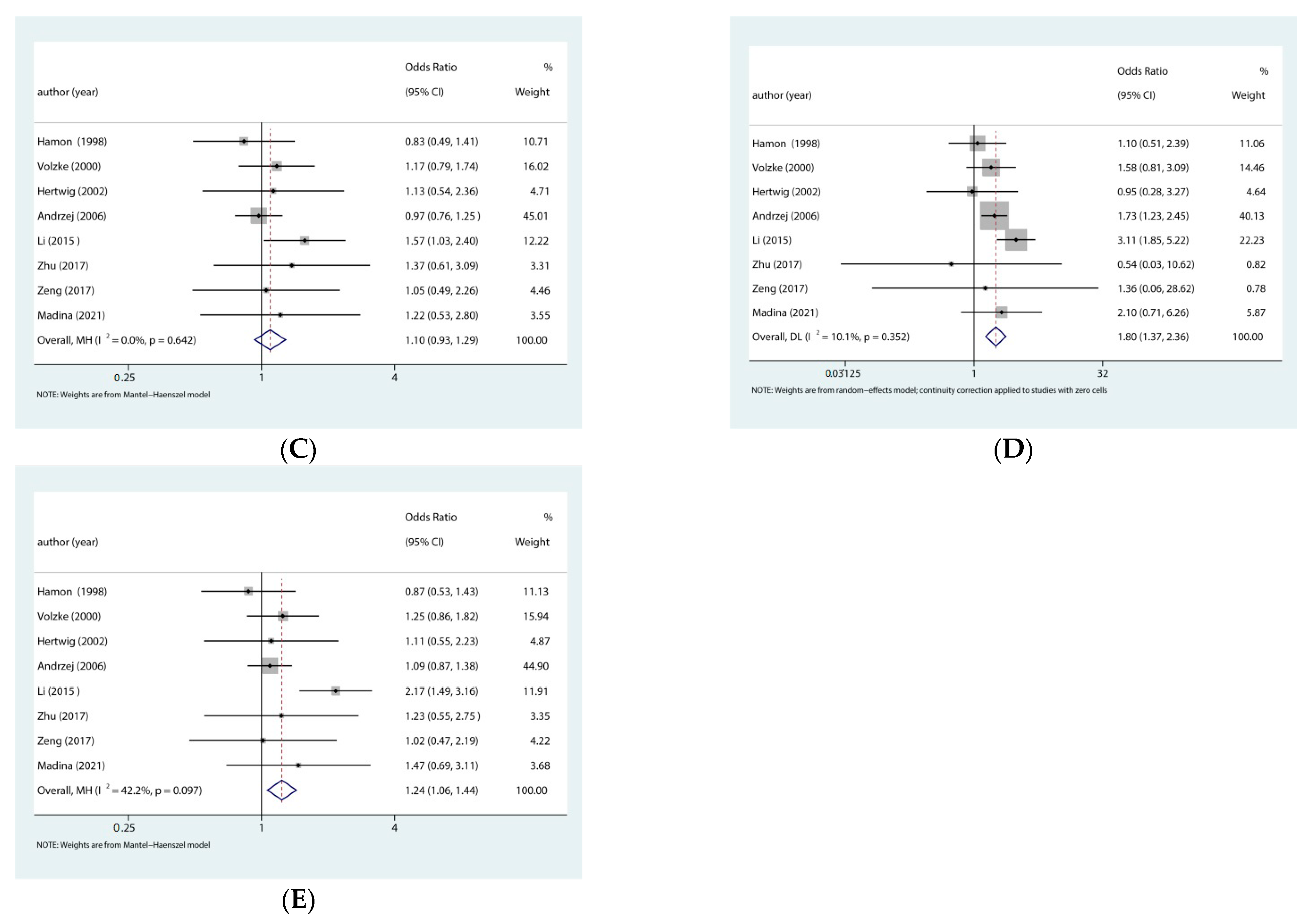

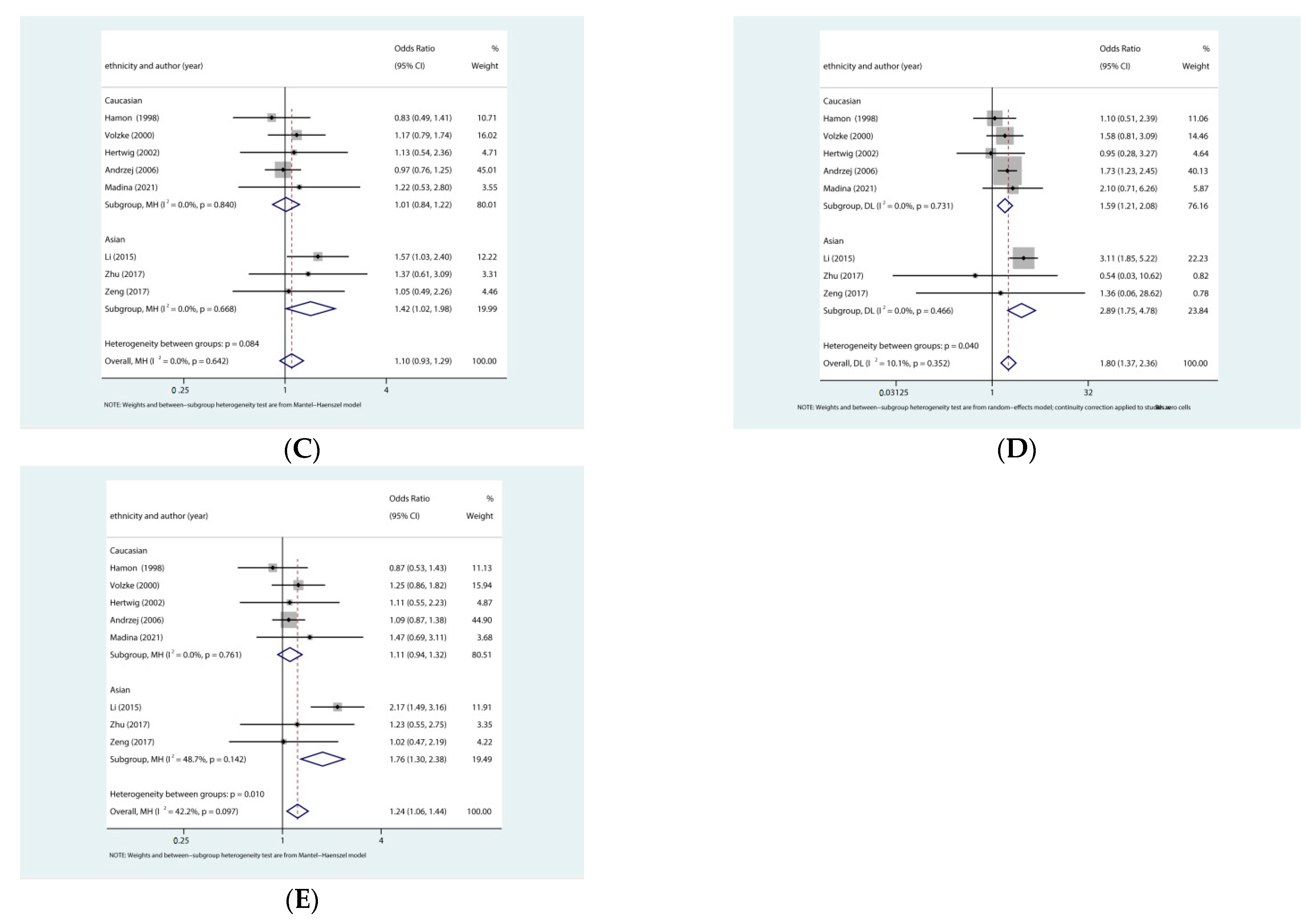
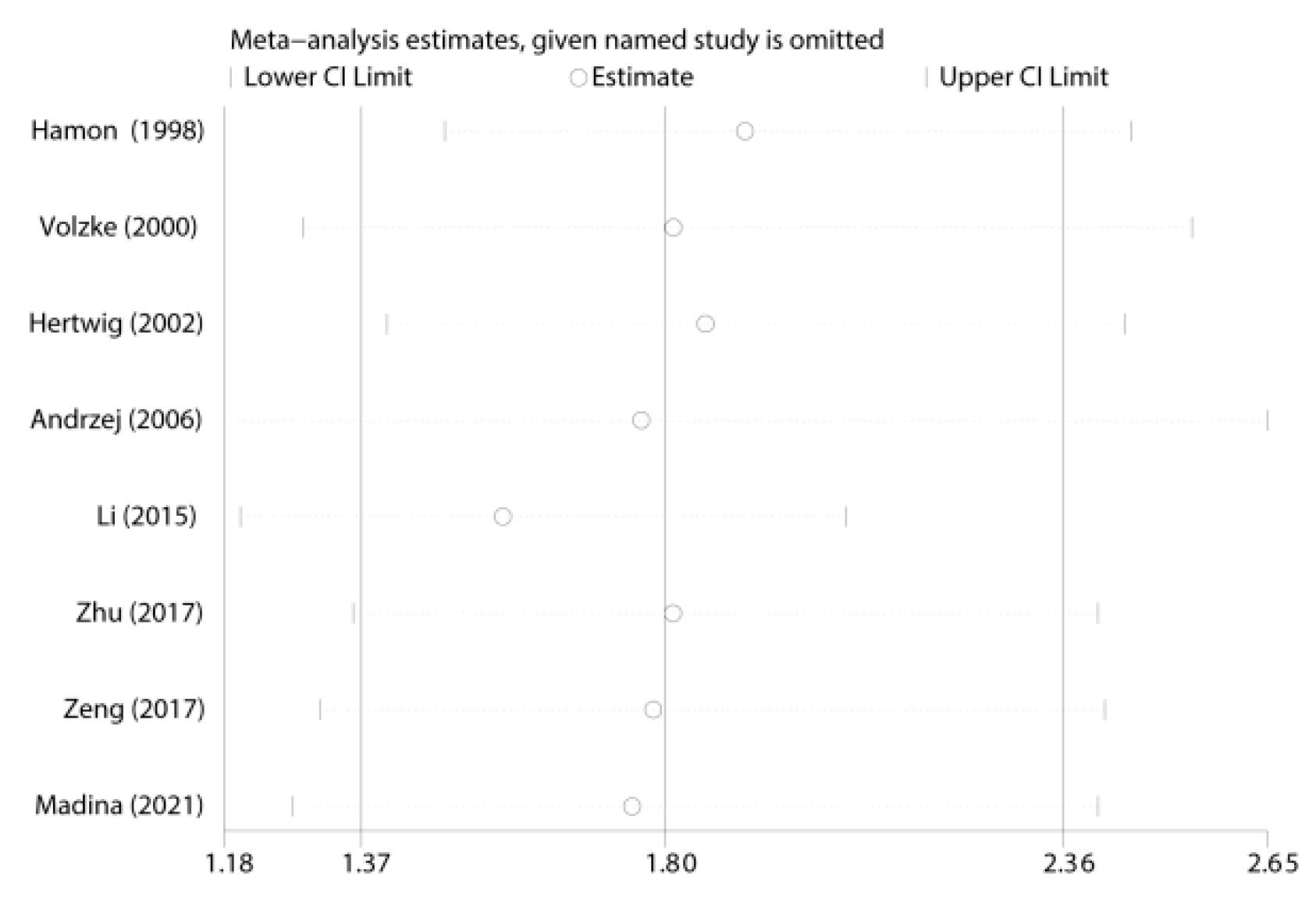
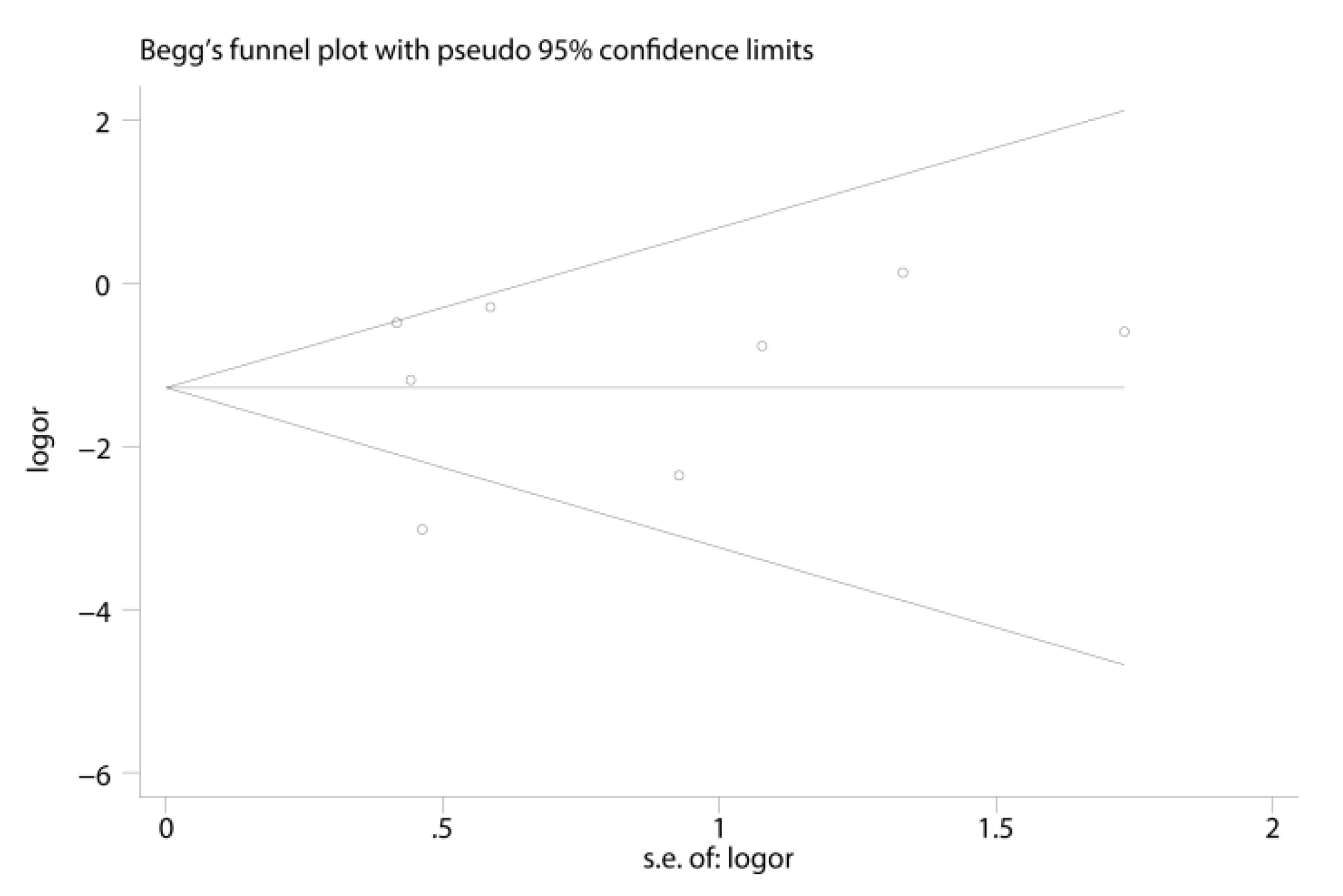
| Author | Year | Country | Ethnicity | Age (Years) | Gender (M/F) | Comorbidities | Source of Controls | Genotyping Method | Polymorphism | NOS Score | HWE Test | ||
|---|---|---|---|---|---|---|---|---|---|---|---|---|---|
| Case | Control | Case | Control | ||||||||||
| Hamon et al. [13] | 1998 | France | Caucasian | NR | 229/42 | HTN, diabetes, CAD | HB | PCR | rs5186 | 7 | 0.35 | ||
| Volzke et al. [14] | 2000 | Germany | Caucasian | 59.9 (8.9) | 60.6 (8.6) | 126/34 | 262/89 | HTN, diabetes, CAD | HB | PCR–RFLP | rs5186 | 8 | 0.96 |
| Hertwig et al. [15] | 2002 | Germany | Caucasian | 59.7 (7.9) | 58.7 (9.2) | 37/9 | 80/19 | HTN, diabetes, CAD | HB | PCR–RFLP | rs5186 | 7 | 0.60 |
| Wijpkema et al. [16] | 2006 | The Netherlands | Caucasian | 62 (11) | 2121/825 | HTN, diabetes, CAD | HB | PCR–RFLP | rs5186 | 8 | 0.12 | ||
| Li et al. [17] | 2015 | China | Asian | 72.2 (4.2) | 72.2 (4.1) | 138/169 | 85/91 | HTN, diabetes, CAD | HB | PCR–RFLP | rs5186 | 6 | 0.04 |
| Zhu et al. [18] | 2017 | China | Asian | 65.3 (11.5) | 63.7 (11.6) | 59/16 | 205/72 | HTN, diabetes, CAD | HB | PCR | rs5186 | 7 | 0.36 |
| Zeng et al. [19] | 2017 | China | Asian | 61.3 (6) | 60.5 (6.15) | 41/13 | 273/98 | HTN, diabetes, CAD | HB | PCR | rs5186 | 8 | 0.65 |
| Azova et al. [20] | 2021 | Russian | Caucasian | 60 (10.1) | 58.8 (8) | 94/19 | HTN, diabetes, CAD | HB | PCR–RFLP | rs5186 | 7 | 0.20 | |
| Author | Selection | Comparability | Exposure |
|---|---|---|---|
| Hamon et al. [13] | *** | ** | ** |
| Volzke et al. [14] | *** | ** | *** |
| Hertwig et al. [15] | *** | ** | ** |
| Wijpkema et al. [16] | *** | ** | *** |
| Li et al. [17] | ** | ** | ** |
| Zhu et al. [18] | *** | ** | ** |
| Zeng et al. [19] | *** | ** | *** |
| Azova et al. [20] | *** | ** | ** |
| Genotype (N) | Allele Frequency (N, %) | |||||||||||||
|---|---|---|---|---|---|---|---|---|---|---|---|---|---|---|
| Cases | Controls | Cases | Controls | |||||||||||
| Author | Total | AA | AC | CC | Total | AA | AC | CC | C | A | RAF | C | A | RAF |
| Hamon et al. [13] | 103 | 55 | 36 | 12 | 168 | 84 | 66 | 18 | 60 | 146 | 0.71 | 102 | 234 | 0.70 |
| Volzke et al. [14] | 160 | 80 | 64 | 16 | 351 | 195 | 133 | 23 | 96 | 224 | 0.70 | 179 | 523 | 0.75 |
| Hertwig et al. [15] | 46 | 23 | 19 | 4 | 99 | 52 | 38 | 9 | 27 | 65 | 0.71 | 56 | 142 | 0.72 |
| Wijpkema et al. [16] | 324 | 150 | 130 | 44 | 2622 | 1271 | 1133 | 218 | 218 | 430 | 0.66 | 1569 | 3675 | 0.70 |
| Li et al. [17] | 307 | 116 | 100 | 91 | 176 | 100 | 55 | 21 | 282 | 332 | 0.54 | 97 | 255 | 0.72 |
| Zhu et al. [18] | 65 | 56 | 9 | 0 | 251 | 222 | 26 | 3 | 9 | 121 | 0.93 | 32 | 470 | 0.94 |
| Zeng et al. [19] | 54 | 45 | 9 | 0 | 371 | 310 | 59 | 2 | 9 | 99 | 0.92 | 63 | 679 | 0.92 |
| Azova et al. [20] | 52 | 25 | 17 | 10 | 59 | 34 | 19 | 6 | 37 | 67 | 0.64 | 31 | 87 | 0.74 |
| Subgroup | Number | Odds Ratio | 95% Confidential Interval | p Value | I2 (%) | |
|---|---|---|---|---|---|---|
| Allele model | ||||||
| Ethnicity | Caucasian | 5 | 1.18 | (1.03, 1.34) | 0.02 | 0.0 |
| Asian | 3 | 1.89 | (1.48, 2.40) | <0.001 | 69 | |
| Sample Size | ≥400 | 4 | 1.37 | (1.21, 1.56) | <0.001 | 80 |
| <400 | 4 | 1.09 | (0.84, 1.41) | 0.52 | 0.0 | |
| PCI type | PTCA | 3 | 1.11 | (0.90, 1.38) | 0.324 | 0.0 |
| Stent | 5 | 1.40 | (1.22, 1.60) | <0.001 | 74 | |
| Homozygote model | ||||||
| Ethnicity | Caucasian | 5 | 1.58 | (1.19, 2.09) | 0.002 | 0.0 |
| Asian | 3 | 3.35 | (1.99, 5.64) | <0.001 | 0.0 | |
| Sample Size | ≥400 | 4 | 2.15 | (1.64, 2.82) | <0.001 | 50 |
| <400 | 4 | 1.19 | (0.68, 2.10) | 0.55 | 0.0 | |
| PCI type | PTCA | 3 | 1.30 | (0.80, 2.11) | 0.29 | 0 |
| Stent | 5 | 2.21 | (1.66, 2.93) | <0.001 | 37 | |
| Heterozygote model | ||||||
| Ethnicity | Caucasian | 5 | 1.01 | (0.84, 1.22) | 0.88 | 0.0 |
| Asian | 3 | 1.42 | (1.02, 1.98) | 0.04 | 0.0 | |
| Sample Size | ≥400 | 4 | 1.11 | (0.93, 1.33) | 0.26 | 20 |
| <400 | 4 | 1.04 | (0.73, 1.47) | 0.84 | 0.0 | |
| PCI type | PTCA | 5 | 1.05 | (0.79, 1.41) | 0.74 | 0.0 |
| Stent | 3 | 1.12 | (0.92, 1.35) | 0.27 | 0.0 | |
| Recessive model | ||||||
| Ethnicity | Caucasian | 5 | 1.59 | (1.21, 2.08) | 0.01 | 0.0 |
| Asian | 3 | 2.89 | (1.75, 4.78) | <0.001 | 0.0 | |
| Sample Size | ≥400 | 4 | 2.02 | (1.44, 2.84) | <0.001 | 25 |
| <400 | 4 | 1.23 | (0.71, 2.14) | 0.46 | 0.0 | |
| PCI type | PTCA | 3 | 1.29 | (0.81, 2.06) | 0.29 | 0.0 |
| Stent | 5 | 2.07 | (1.53, 2.81) | <0.001 | 5.5 | |
| Dominant model | ||||||
| Ethnicity | Caucasian | 5 | 1.11 | (0.94, 1.32) | 0.23 | 0.0 |
| Asian | 3 | 1.76 | (1.30, 2.38) | <0.001 | 49 | |
| Sample Size | ≥400 | 4 | 1.27 | (1.09, 1.52) | <0.001 | 69 |
| <400 | 4 | 1.07 | (0.77, 1.48) | 0.69 | 0.0 | |
| PCI type | PTCA | 3 | 1.10 | (0.83, 1.44) | 0.51 | 0.0 |
| Stent | 5 | 1.24 | (1.06, 1.44) | 0.004 | 59 |
Publisher’s Note: MDPI stays neutral with regard to jurisdictional claims in published maps and institutional affiliations. |
© 2022 by the authors. Licensee MDPI, Basel, Switzerland. This article is an open access article distributed under the terms and conditions of the Creative Commons Attribution (CC BY) license (https://creativecommons.org/licenses/by/4.0/).
Share and Cite
Lv, F.; Jiang, Y.; Wang, Y.; Zhang, T.; Zhou, Y. AGTR1rs5186 Polymorphism Is Associated with the Risk of Restenosis after Percutaneous Coronary Intervention: A Meta-Analysis. J. Cardiovasc. Dev. Dis. 2022, 9, 406. https://doi.org/10.3390/jcdd9110406
Lv F, Jiang Y, Wang Y, Zhang T, Zhou Y. AGTR1rs5186 Polymorphism Is Associated with the Risk of Restenosis after Percutaneous Coronary Intervention: A Meta-Analysis. Journal of Cardiovascular Development and Disease. 2022; 9(11):406. https://doi.org/10.3390/jcdd9110406
Chicago/Turabian StyleLv, Feng, Yufeng Jiang, Yebao Wang, Ting Zhang, and Yafeng Zhou. 2022. "AGTR1rs5186 Polymorphism Is Associated with the Risk of Restenosis after Percutaneous Coronary Intervention: A Meta-Analysis" Journal of Cardiovascular Development and Disease 9, no. 11: 406. https://doi.org/10.3390/jcdd9110406
APA StyleLv, F., Jiang, Y., Wang, Y., Zhang, T., & Zhou, Y. (2022). AGTR1rs5186 Polymorphism Is Associated with the Risk of Restenosis after Percutaneous Coronary Intervention: A Meta-Analysis. Journal of Cardiovascular Development and Disease, 9(11), 406. https://doi.org/10.3390/jcdd9110406






